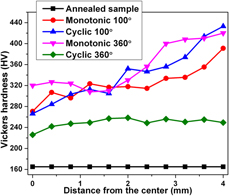Crossref Citations
This article has been cited by the following publications. This list is generated based on data provided by
Crossref.
Weng, Fei
Chew, Youxiang
Zhu, Zhiguang
Yao, Xiling
Wang, Leilei
Ng, Fern Lan
Liu, Shibo
and
Bi, Guijun
2020.
Excellent combination of strength and ductility of CoCrNi medium entropy alloy fabricated by laser aided additive manufacturing.
Additive Manufacturing,
Vol. 34,
Issue. ,
p.
101202.
Sonkusare, Reshma
Biswas, Krishanu
Al-Hamdany, Nowfal
Brokmeier, H.G.
Kalsar, R.
Schell, Norbert
and
Gurao, N.P.
2020.
A critical evaluation of microstructure-texture-mechanical behavior heterogeneity in high pressure torsion processed CoCuFeMnNi high entropy alloy.
Materials Science and Engineering: A,
Vol. 782,
Issue. ,
p.
139187.
Bahadur, Fateh
Biswas, Krishanu
and
Gurao, N.P.
2020.
Micro-mechanisms of microstructural damage due to low cycle fatigue in CoCuFeMnNi high entropy alloy.
International Journal of Fatigue,
Vol. 130,
Issue. ,
p.
105258.
Sinha, Subhasis
Sahu, Vivek K.
Beura, Vikrant
Sonkusare, Reshma
Kalsar, Rajib
Das, Aman K.L.
Basu, Joysurya
Gurao, Nilesh P.
and
Biswas, Krishanu
2021.
Initial texture dependence of nanocrystalline omega phase formation during high pressure torsion of commercially pure titanium.
Materials Science and Engineering: A,
Vol. 802,
Issue. ,
p.
140687.
KARIMI, Mohammad Ali
SHAMANIAN, Morteza
and
ENAYATI, Mohammad Hossein
2021.
Microstructural and mechanical properties assessment of transient liquid phase bonding of CoCuFeMnNi high entropy alloy.
Transactions of Nonferrous Metals Society of China,
Vol. 31,
Issue. 10,
p.
3063.
Zhang, Yitan
Liu, Maowen
Sun, Jingyong
Li, Guodong
Zheng, Ruixiao
Xiao, Wenlong
and
Ma, Chaoli
2022.
Excellent thermal stability and mechanical properties of bulk nanostructured FeCoNiCu high entropy alloy.
Materials Science and Engineering: A,
Vol. 835,
Issue. ,
p.
142670.
Sabban, Rushikesh
Dash, K.
Suwas, S.
and
Murty, B. S.
2022.
Strength–Ductility Synergy in High Entropy Alloys by Tuning the Thermo-Mechanical Process Parameters: A Comprehensive Review.
Journal of the Indian Institute of Science,
Vol. 102,
Issue. 1,
p.
91.
Nie, Xiaowu
Sheng, Mingqiang
and
Mabi, Awei
2022.
Effect of SPS Sintering Process on Compressive Strength and Magnetic Properties of CoCuFeMnNi Bulk Alloy.
JOM,
Vol. 74,
Issue. 7,
p.
2665.
Bibhanshu, Nitish
Prasad, Natasha
Nayan, Niraj
Avadhani, G.S.
Ray, R.K.
and
Suwas, Satyam
2022.
Mechanical response of as-cast equiatomic high entropy alloy CuFeCoNiMn.
Intermetallics,
Vol. 143,
Issue. ,
p.
107461.
Azzeddine, Hiba
Bradai, Djamel
Baudin, Thierry
and
Langdon, Terence G.
2022.
Texture evolution in high-pressure torsion processing.
Progress in Materials Science,
Vol. 125,
Issue. ,
p.
100886.
Biswas, Krishanu
Gurao, Nilesh Prakash
Maiti, Tanmoy
and
Mishra, Rajiv S.
2022.
High Entropy Materials.
p.
195.
Aydinyan, S.
Kirakosyan, H.
Sargsyan, A.
Volobujeva, O.
and
Kharatyan, S.
2022.
Solution combustion synthesis of MnFeCoNiCu and (MnFeCoNiCu)3O4 high entropy materials and sintering thereof.
Ceramics International,
Vol. 48,
Issue. 14,
p.
20294.
Edalati, Parisa
Fuji, Masayoshi
and
Edalati, Kaveh
2023.
Superfunctional high-entropy alloys and ceramics by severe plastic deformation.
Rare Metals,
Vol. 42,
Issue. 10,
p.
3246.
Sonkusare, Reshma
Gurao, N.P.
Biswas, Krishanu
Basu, Joysurya
Sen, S.
Pradeep, K.G.
Praveena, Manimunda
Bhowmick, Sanjit
Bhowmick, Somnath
Kilmametov, A.
and
Palit, M.
2023.
Micro-mechanisms of deformation and strengthening during high pressure torsion of CoCuFeMnNi high entropy alloy.
Materialia,
Vol. 32,
Issue. ,
p.
101916.
Li, Shu-Cong
Wang, Qing-Lin
Yao, Yu
Sang, Dan-Dan
Zhang, Hai-Wa
Zhang, Guo-Zhao
Wang, Cong
and
Liu, Cai-Long
2023.
Application of high-pressure technology in exploring mechanical properties of high-entropy alloys.
Tungsten,
Vol. 5,
Issue. 1,
p.
50.
Kumar, Jitesh
Jha, Saumya R.
Gurao, N. P.
and
Biswas, Krishanu
2023.
New Horizons in Metallurgy, Materials and Manufacturing.
p.
159.
Zhang, Baoyu
Zeng, Yuning
Pang, Xueqin
and
Deng, Wenjun
2023.
Fretting wear behaviour of ultrafine-grained copper produced by cryogenic temperature extrusion machining.
Materials Science and Technology,
Vol. 39,
Issue. 8,
p.
954.
Edalati, Kaveh
Ahmed, Anwar Q.
Akrami, Saeid
Ameyama, Kei
Aptukov, Valery
Asfandiyarov, Rashid N.
Ashida, Maki
Astanin, Vasily
Bachmaier, Andrea
Beloshenko, Victor
Bobruk, Elena V.
Bryła, Krzysztof
Cabrera, José María
Carvalho, Amanda P.
Chinh, Nguyen Q.
Choi, In-Chul
Chulist, Robert
Cubero-Sesin, Jorge M.
Davdian, Gregory
Demirtas, Muhammet
Divinski, Sergiy
Durst, Karsten
Dvorak, Jiri
Edalati, Parisa
Emura, Satoshi
Enikeev, Nariman A.
Faraji, Ghader
Figueiredo, Roberto B.
Floriano, Ricardo
Fouladvind, Marjan
Fruchart, Daniel
Fuji, Masayoshi
Fujiwara, Hiroshi
Gajdics, Marcell
Gheorghe, Diana
Gondek, Łukasz
González-Hernández, Joaquín E.
Gornakova, Alena
Grosdidier, Thierry
Gubicza, Jenő
Gunderov, Dmitry
He, Liqing
Higuera, Oscar Fabian
Hirosawa, Shoichi
Hohenwarter, Anton
Horita, Zenji
Horky, Jelena
Huang, Yi
Huot, Jacques
Ikoma, Yoshifumi
Ishihara, Tatsumi
Ivanisenko, Yulia
Jang, Jae-il
Jorge, Alberto M.
Kawabata-Ota, Mie
Kawasaki, Megumi
Khelfa, Tarek
Kobayashi, Junya
Kommel, Lembit
Korneva, Anna
Kral, Petr
Kudriashova, Natalia
Kuramoto, Shigeru
Langdon, Terence G.
Lee, Dong-Hyun
Levitas, Valery I.
Li, Cong
Li, Hai-Wen
Li, Yongtao
Li, Zheng
Lin, Huai-Jun
Liss, Klaus-Dieter
Liu, Ying
Cardona, Diana Maritza Marulanda
Matsuda, Kenji
Mazilkin, Andrey
Mine, Yoji
Miyamoto, Hiroyuki
Moon, Suk-Chun
Müller, Timo
Muñoz, Jairo Alberto
Murashkin, Maxim Yu.
Naeem, Muhammad
Novelli, Marc
Olasz, Dániel
Pippan, Reinhard
Popov, Vladimir V.
Popova, Elena N.
Purcek, Gencaga
de Rango, Patricia
Renk, Oliver
Retraint, Delphine
Révész, Ádám
Roche, Virginie
Rodriguez-Calvillo, Pablo
Romero-Resendiz, Liliana
Sauvage, Xavier
Sawaguchi, Takahiro
Sena, Hadi
Shahmir, Hamed
Shi, Xiaobin
Sklenicka, Vaclav
Skrotzki, Werner
Skryabina, Nataliya
Staab, Franziska
Straumal, Boris
Sun, Zhidan
Szczerba, Maciej
Takizawa, Yoichi
Tang, Yongpeng
Valiev, Ruslan Z.
Vozniak, Alina
Voznyak, Andrei
Wang, Bo
Wang, Jing Tao
Wilde, Gerhard
Zhang, Fan
Zhang, Meng
Zhang, Peng
Zhou, Jianqiang
Zhu, Xinkun
and
Zhu, Yuntian T.
2024.
Severe plastic deformation for producing superfunctional ultrafine-grained and heterostructured materials: An interdisciplinary review.
Journal of Alloys and Compounds,
Vol. 1002,
Issue. ,
p.
174667.
Mahato, Swati
Chandrakar, Shirish
Biswas, Krishanu
and
Gurao, Nilesh P.
2024.
An experimental and crystal plasticity simulation study on kink band-assisted grain fragmentation during high-pressure torsion of (CrFeNi)99Si1 medium-entropy alloy.
Journal of Materials Science,
Vol. 59,
Issue. 14,
p.
6075.
